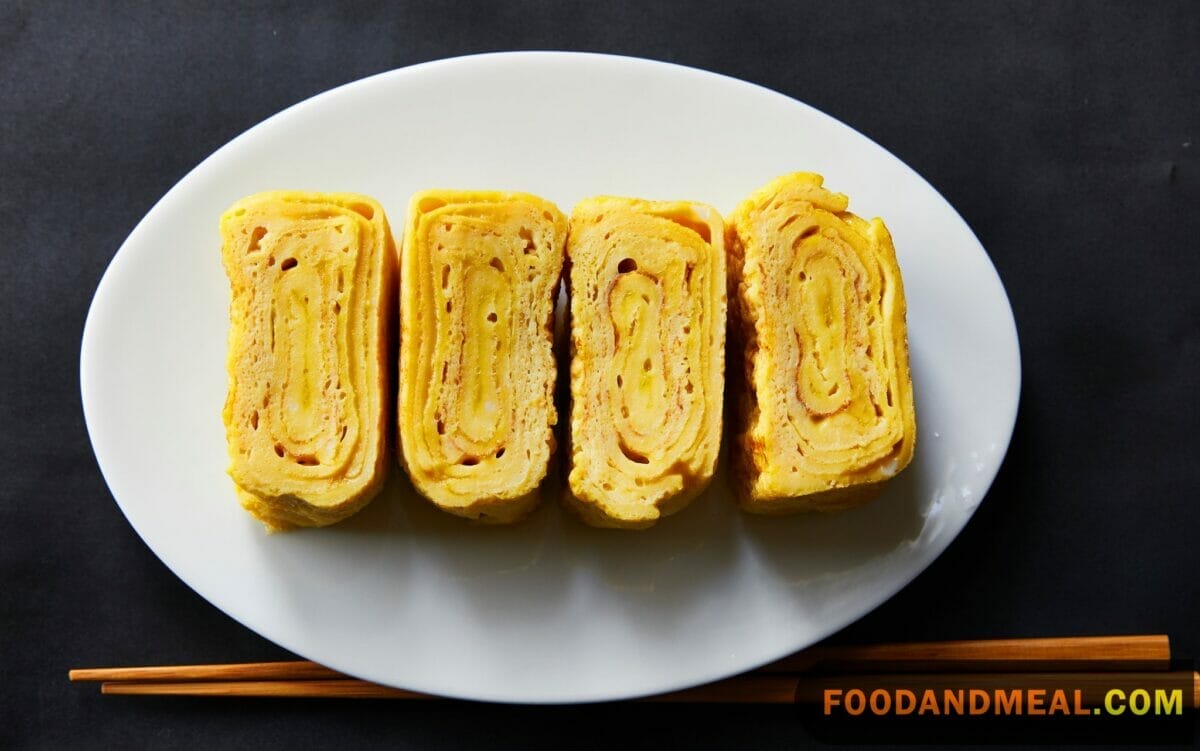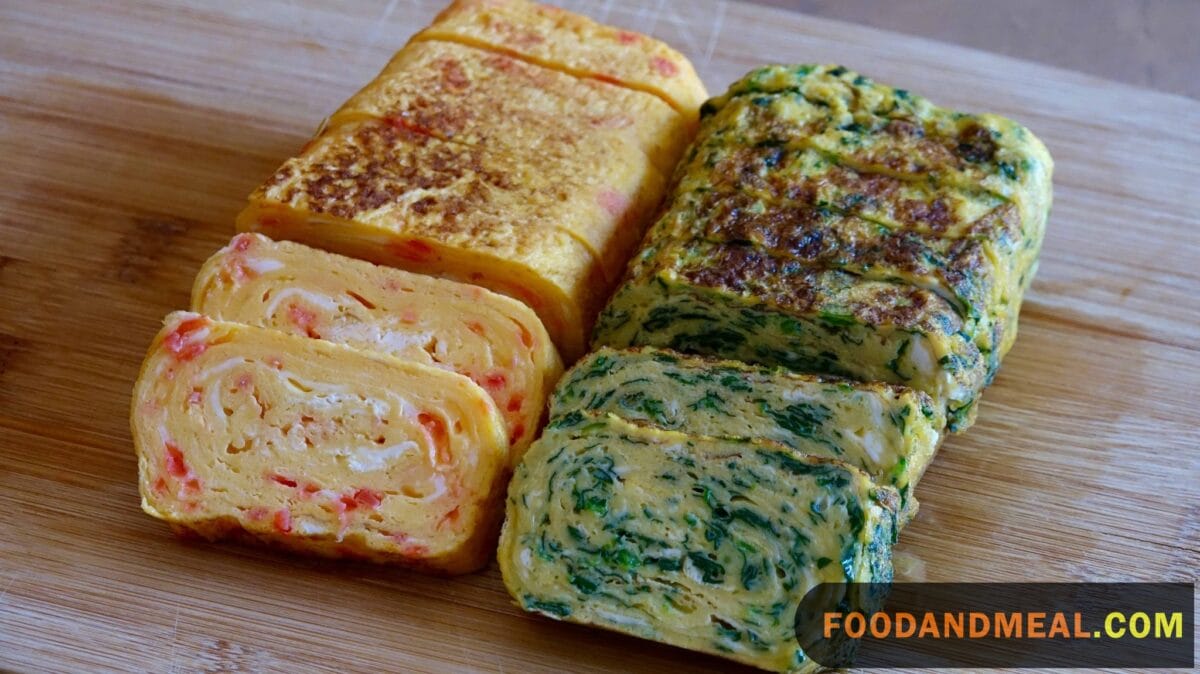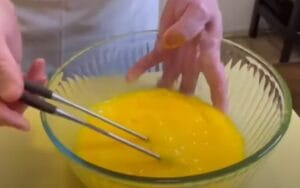Learn how to make tamagoyaki – a sweet Japanese rolled omelette with dashi, mirin and salmon. A comforting recipe from my travels.
Lately I’ve become fascinated with Japanese cuisine, especially after a recent trip to Tokyo. One dish in particular that captured my attention was tamagoyaki, a type of sweet rolled omelette that I enjoyed every morning for breakfast.
The first time I took a bite, I was amazed by the light sweetness paired with the soft, almost custard-like texture of the egg. It was so comforting and satisfying! When I returned home, I just had to learn how to make Tamagoyaki myself so I could recreate that wonderful experience.
After some experimenting in my kitchen, I’m thrilled to share my take on Japanese rolled egg – a dish that has quickly become one of my absolute favorites. The dashi stock adds a lovely umami depth, while the mirin and sugar provide a subtle sweetness. I like to add salmon flakes and scallions to give it even more flavor. The end result is a Japanese-inspired comfort food that makes me smile every time I take a bite. It brings back fond memories of my travels and motivates me to continue exploring new cuisines!
I hope you’ll give this tamagoyaki recipe a try. Even if you don’t have a special pan (don’t worry, I share tips for using a regular frying pan), it’s approachable enough for weeknight cooking. Let me know what you think! Now if you’ll excuse me, I’m off to enjoy another slice with my morning irish coffee.
What is Tamagoyaki ?
Tamagoyaki, the Japanese omelette with a balance of sweet and savory flavors, is a dish I hold dear for its technique and tradition. It’s made by layering thin sheets of seasoned egg in a rectangle skillet and rolling them into a layered masterpiece. This dish isn’t just a staple for breakfast; it’s versatile enough to enhance bento boxes, pair with rice, or crown sushi rice as nigiri.
The process of making tamagoyaki is a delicate dance, requiring a harmonious blend of eggs, soy sauce, mirin, and sugar, cooked in stages to form a fluffy omelette. The key is to cook the eggs gently, avoiding browning, to maintain their vibrant color and soft texture. Cutting into the tamagoyaki reveals the beautiful layers, each one a testament to the chef’s skill.
How to make Tamagoyaki
Tamagoyaki is a sweet Japanese rolled omelette that makes for a comforting breakfast or snack. It has a light sweetness from mirin and sugar that pairs nicely with the soft, custard-like texture of the eggs. Salmon flakes and scallions add savory umami flavor and texture.
Making Japanese rolled omelette does take some practice to master the rolling technique, but with patience you’ll be making restaurant-quality tamagoyaki in no time. This recipe calls for a special rectangular omelette pan, but you can also use a regular frying pan.


Tamagoyaki
Ingredients
- 2 large eggs
- 1/2 nori
- 1 1/2 tsp. white sugar
- 1 tsp. milk
- 2 tsp. chopped carrots
- 2 tsp. finely chopped spring onions
- 2 tbsp. canola oil
Instructions
- In a clean small bowl, whisk the egg, milk, sugar, and nori. Set aside

- Heat the oil in a large clean nonstick skillet

- Toss in and fry the onions and carrots for 1 minute

- Remove from the heat and pour content into the egg mixture. Stir well and pour back into the greased saucepan

- When the egg begins to form, roll it over to form a wrap

- Sauté for 2 minutes, allowing it to cook through

- Transfer to a flat plate and cut into rolls

- Have fun with Rice and Nori!

Video
Notes
Nutrition
© Food And Meal
This website provides approximate nutrition information for convenience and as a courtesy only. Nutrition data is gathered primarily from the Spoonacular Database, whenever available, or otherwise other online calculators.
Japanese Egg Omelets in the Oven

Preheat your oven to 325°F (165°C), a moderate heat to gently coax the eggs into forming the plush layers we desire. While the oven hums away, whisk together your eggs, a touch of sugar for a subtle sweetness that is characteristic of tamagoyaki, a dash of soy for depth, and perhaps a sprinkle of mirin for a gentle tang. The ratios are not set in stone; they dance to the tune of personal taste, much like a melody varies with each musician’s rendition.
Line a rectangular baking dish with parchment paper, ensuring it overhangs slightly for easy removal later. This is our modern substitute for the traditional makiyakinabe pan. Gently pour in the egg mixture, and then, as an artist would, tilt the dish to ensure an even spread, a canvas waiting to be transformed.
Now, here’s where patience plays its part. Slide the dish into the oven and let it bake, undisturbed, for about 12 to 15 minutes. What you’re looking for is a set yet custardy texture, a stage just before the eggs think about browning.
Once achieved, pull the dish from the oven and breathe in the warmth of your creation. Begin rolling the egg while it’s still in the dish, starting from one end and gently pressing down as you go. The parchment paper is your ally here, preventing any stickiness and allowing for a smooth roll.
The Japanese rolled egg now needs to rest, cradled in the parchment, to hold its shape and meld the layers together in a warm embrace. As it cools, prepare a bamboo mat by wrapping it in plastic wrap – this is not just a tool for sushi. Place the slightly cooled egg roll onto the mat and roll it tightly, giving it that signature cylindrical shape.
After a short rest, unveil your tamagoyaki. It should have a soft, yielding texture, with swirls that tell tales of the layers within. Slice into bite-sized pieces, revealing a cross-section that flaunts its spiral beauty, a testament to your craftsmanship.
Serve these golden rounds with a light brushing of soy sauce, or perhaps a dab of wasabi or pickled ginger on the side, to add a zesty counterpoint to the sweet, layered embrace of the eggs.
In crafting tamagoyaki in the oven, we’ve taken a detour from the conventional, inviting both surprise and comfort, like finding a blossoming cherry tree in an unexpected corner of the city. And as you share this recipe with your readers, you’re not just offering them a dish; you’re offering them an experience that marries the reverence for tradition with the thrill of innovation.
Expert Tips for making Japanese rolled egg

Cooking Tips about Tamagoyaki Japanese omelette
Creating the perfect tamagoyaki begins with quality ingredients. Fresh eggs are paramount, as they are the stars of the dish. The addition of seasonings like sugar, soy sauce, and mirin (a sweet rice wine) balances the eggs’ natural savoriness with a subtle sweetness and depth of flavor.
The pan used for tamagoyaki, traditionally a rectangular makiyakinabe, plays a crucial role. Its shape helps achieve the iconic layers and allows for easier rolling. However, if such a pan isn’t available, a regular non-stick skillet can suffice with a bit of practice.
The technique in pouring and rolling the egg mixture is where the challenge truly lies. Pouring a thin layer and letting it set slightly before rolling requires a gentle touch. The pan must be at just the right temperature – too hot, and the eggs will cook too quickly and brown, losing their characteristic pale yellow hue; too cool, and they won’t set properly, making them difficult to roll.
To infuse emotion into this culinary experience, one must approach Japanese rolled omelette with mind fulness and joy. There’s a rhythm to the process: pouring, tilting the pan to spread the egg, watching for the right moment to roll, then starting the cycle anew with another layer. It’s almost meditative. Each layer represents a new beginning, a chance to improve upon the last. The repetitive nature of the task allows for reflection and improvement, which can be quite fulfilling.
In terms of personal opinions, I find tamagoyaki to be a delightful expression of culinary skill. It’s a versatile dish that can be enjoyed in various contexts, whether it’s a simple breakfast, part of a bento box lunch, or served at a sushi bar. While the learning curve may seem steep at first, the satisfaction gained from creating a beautifully layered egg omelet is immensely gratifying. It’s a testament to the beauty of Japanese cuisine, where even the simplest dishes are crafted with a profound sense of care and precision.
Serving Suggestions about tamagoyaki Japanese rolled omelette

For breakfast or brunch, tamagoyaki can be served alongside Soy Milk or Oat Milk for those who prefer a light start to their day. The creaminess of the milk contrasts nicely with the fluffy texture of the omelette.
In a bento box or as part of a more substantial lunch, Japanese omelettecould be accompanied by Gyoza for a satisfying combination of crisp dumplings and soft omelette. Adding a side of Miso Soup would provide a soothing umami-rich broth to balance the meal.
For a sushi bar experience, pairing tamagoyaki with Sashimi would allow the delicate flavors of raw fish to shine, complemented by the seasoned omelette. A small dish of Wasabi could be included for those who enjoy a spicy kick.
In a dinner setting, Japanese rolled egg could be served alongside Yakisoba for a hearty and flavorful noodle dish, with the omelette adding a protein-rich component. Butajiru, a pork and vegetable soup, could also serve as a warming and comforting addition to the meal.
For a fusion twist, one might consider serving tamagoyaki with unconventional but harmonious sides such as Miso Salmon or Teriyaki Shrimp, blending Japanese flavors with the unique qualities of rolled omelette.
Top 9 FAQs about Tamagoyaki Recipes
- Can I make Tamagoyaki Scramble ahead of time? Yes, you can make it in advance and store it in the fridge. Reheat it gently in a pan or microwave when you’re ready to eat.
- What other ingredients can I add to my egg omelet? Feel free to experiment! Add ingredients like mushrooms, bell peppers, shredded carrots, or even cooked shrimp for variety.
- Can I make a sweet Tamagoyaki? Certainly! You can add sugar to the egg mixture for a sweet version. It’s delightful with a sprinkle of powdered sugar on top.
- What is the best type of pan for making Tamagoyaki? A rectangular Japanese omelette frying pan is traditional, but a non-stick square or round pan works well. The key is that it’s non-stick.
- How long does Japanese omelette keep in the fridge? It can be stored for up to 2-3 days in the refrigerator. Cover it to prevent drying out.
- What makes a good tamagoyaki? A good rolled omelette is characterized by a soft, moist texture, well-defined layers, and a balanced combination of sweet and savory flavors.
- Does tamagoyaki have to be sweet? No, The egg omelet doesn’t have to be sweet, but it often has a mildly sweet taste. The sweetness can vary based on personal preference and regional variations.
- What does tamagoyaki contain? Japanese omelette typically contains eggs, sugar, soy sauce, and mirin. Additional ingredients like dashi, salt, or vegetables can be added for flavor variation.
- Is tamagoyaki eaten hot or cold? The Rolled omelette can be enjoyed both hot and cold. It’s often served warm, but it’s also a popular choice for bento boxes and sushi, where it’s served at room temperature or chilled.
Conclution

I hope this how to make tamagoyaki guide has inspired you to give egg omelet a try. It’s such a comforting, flavorful dish that is perfect for breakfast, lunch, or even dinner. While it does take some practice to master rolling the omelette just right, don’t get discouraged if your first attempt doesn’t come out perfectly. With a little patience, I’m confident you’ll be making restaurant-quality tamagoyaki in no time.
Let me know in the comments how your tamagoyaki turns out! I’d love to see photos of your creations and hear any tips or tweaks you make to this recipe. And if you have any other Japanese dishes you’d like me to tackle, please let me know. I had such an incredible culinary experience during my trip and I’d love to continue exploring the wide world of Japanese cooking. Itadakimasu!












